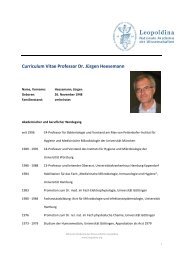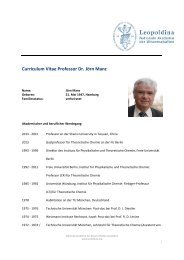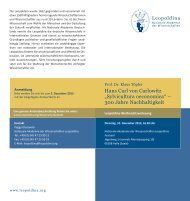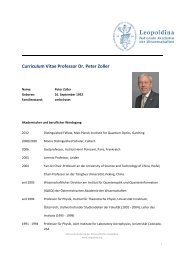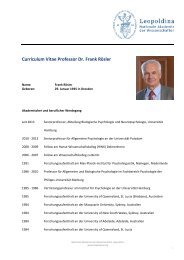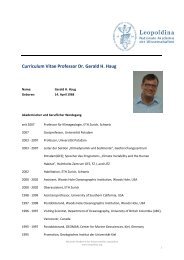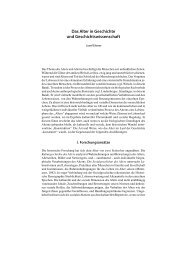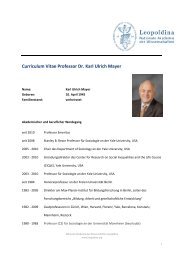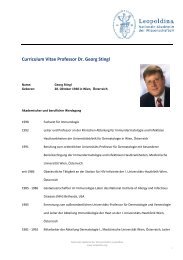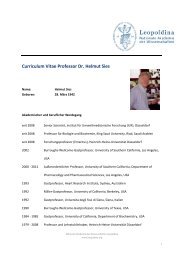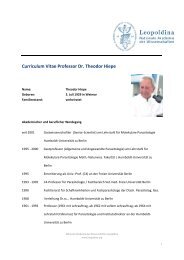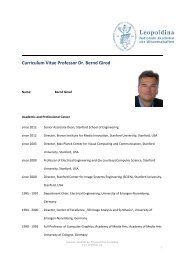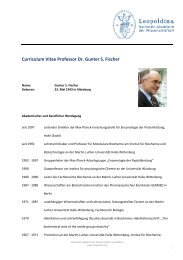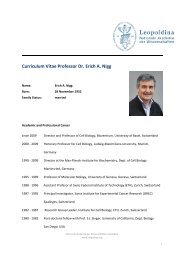Neu gewählte Mitglieder 2005 (pdf) - Leopoldina
Neu gewählte Mitglieder 2005 (pdf) - Leopoldina
Neu gewählte Mitglieder 2005 (pdf) - Leopoldina
Sie wollen auch ein ePaper? Erhöhen Sie die Reichweite Ihrer Titel.
YUMPU macht aus Druck-PDFs automatisch weboptimierte ePaper, die Google liebt.
Prof. Dr.-Ing.<br />
Pierre Braunstein<br />
*October 4, 1947 Mulhouse (France)<br />
Section: Chemistry<br />
Matricula number: 7029<br />
Date of election: June 29, <strong>2005</strong><br />
Pierre BrAunStein is Director of Research with the CNRS<br />
and the Director of the Coordination Chemistry Laboratory<br />
(UMR 7177 CNRS) of the Université Louis Pasteur<br />
in Strasbourg (ULP) (France). He graduated from the Ecole Nationale Supérieure<br />
de Chimie de Mulhouse (1969) and obtained his Dr. Ing. (1971) and Doctorat d’Etat<br />
(1974) from the ULP, working on organometallic, metal-metal bonded transition<br />
metal complexes. He is a member of the French Académie des Sciences and of the<br />
Academia Europaea.<br />
After studies at University College London (1971–1972, UK) and the Technische<br />
Universität München (1974 –1975, Germany), he developed his research at ULP on<br />
fundamental aspects and applications of the inorganic and organometallic chemistry<br />
of the transition and main group elements.<br />
His activities range from the development of new concepts in synthetic chemistry,<br />
the synthesis of heterometallic clusters with pioneering work on their use for<br />
the preparation of catalytically active bimetallic nanoparticles (1982), the discovery<br />
of numerous novel reactions and organic and inorganic molecules, to their applications<br />
in homogeneous and heterogeneous catalysis. He has provided a number of<br />
links between separate research areas. With his group, he has significantly contributed<br />
to the development of cluster chemistry, of the hemilability concept, initiated<br />
a bimetallic silicon chemistry, developed the chemistry of phosphinoenolates and<br />
examined various catalytic reactions.<br />
Publications (Selection):<br />
– BrAunStein, P., Knorr, M., and Stern, C.: Bimetallic silicon chemistry: new opportunities in coordination<br />
and organometallic chemistry. Coord. Chem. Rev. 178 –180, 903 –965 (1998)<br />
– BrAunStein, P., and roSé, J.: Heterometallic clusters in catalysis. In: BrAunStein, P., oro, L. A., and<br />
rAithBy, P. R. (Eds.): Metal Clusters in Chemistry. Vol. 2, pp. 616 – 677. Weinheim: Wiley-VCH<br />
1999<br />
– BrAunStein, P., and nAuD, F.: Hemilability of hybrid ligands and the coordination chemistry of oxazoline-based<br />
systems. Angew. Chem. Int. Ed. 40, 680 – 699 (2001)<br />
– SPeiSer, F., BrAunStein, P., and SAuSSine, L.: Catalytic ethylene dimerization and oligomerization:<br />
recent developments with nickel complexes containing P,N-chelating ligands. Acc. Chem. Res. 38,<br />
784 – 793 (<strong>2005</strong>)<br />
– BrAunStein, P.: Bonding and organic and inorganic reactivity of metal-coordinated phosphinoenolates<br />
and related phosphine-derived anions. Chem. Rev. 106, 134 – 159 (2006)<br />
8



